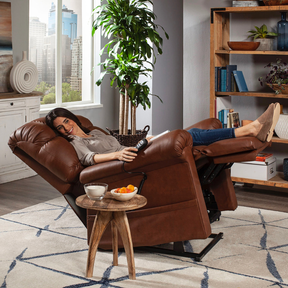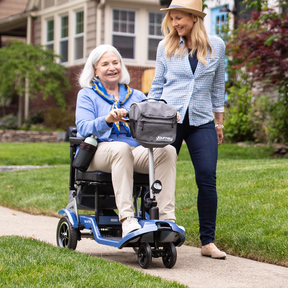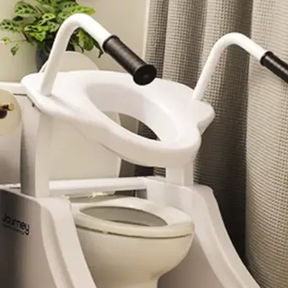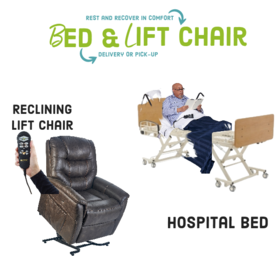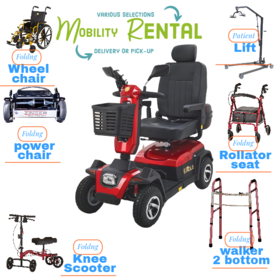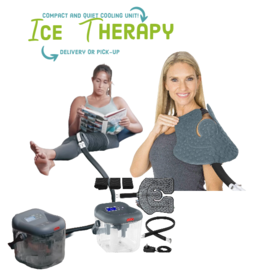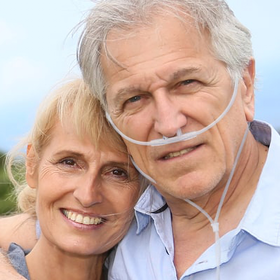Blog Tips to help you get Started with a Portable Oxygen Concentrator
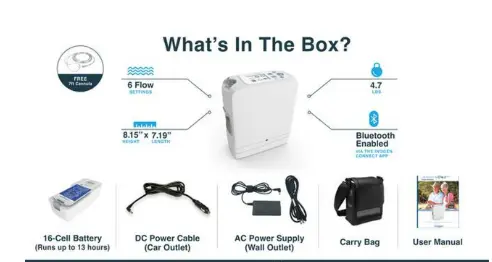
The portable oxygen concentrator (POC) is a device that provides oxygen on the go. A POC works similarly to a home oxygen concentrator by drawing in air and removing nitrogen, then delivering oxygen to the lungs. Your doctor might prescribe a POC if you wear supplemental oxygen outside the house so you can carry the oxygen with you. A portable POC typically weighs around four to five pounds, making it lightweight and portable.
Using a portable oxygen concentrator for the first time might seem intimidating, but with the right information, you will have it up and running in no time. In this article, you'll discover what you'll find in your package when you unbox it, tips for setting up your unit, and how to wear your portable oxygen concentrator.
What's in the Box: Portable Oxygen Concentrators
Ensure you keep the packing and invoice of your POC package when you receive it so that you can refer to them in the future. If you plan to charge your device immediately, opening the box near an outlet is best.
Let's look at what a POC looks like when it's unboxed.
The Manual
An instruction manual is included with each POC unit. It provides information about the POC and accessories and instructions on how to set it up and troubleshoot it. If you have further questions or concerns, you should also be able to contact the manufacturer.
The POC Unit
POC units typically arrive without batteries. Once the unit is out of the box, remove its other accessories and set it aside.
Before beginning setup, make sure your unit's particle filters are installed.
The Battery
There is usually a separate battery pack in the box for concentrator batteries. When using your POC, it's best to charge the battery fully. Most manufacturers send their batteries partially charged.
It depends on which unit you have, how fast you breathe, and the flow setting, but the battery life generally lasts for four hours once fully charged.
AC Adapter
You will plug your POC unit into a wall outlet with your AC adapter. There are usually two pieces to AC adapters. Connect one piece to the other to use.
DC Charger
You can charge your POC on the go by inserting the DC charger into an accessory outlet in your vehicle.
Nasal Cannula
POC units typically come with nasal cannulas. A medical supply store or oxygen supplier can provide extra nasal cannulas.
POC First-Time Setup
Charging your battery
Before using your POC for the first time, ensure the battery is fully charged with the AC adapter or the DC power cord. Depending on your unit, the charge time for your battery will vary. Consult your manual to find out what your battery's charge time is.
The device will continue charging while it is plugged in, so you can still use it while it is charging.
A display screen on the front of a POC unit usually displays the charge left in the battery.
Charge your POC with the DC power cord in a vehicle first, then connect the unit to the car's charging port. Before connecting the DC power cord to the car's charging port, ensure the vehicle is running. Don't forget to keep your POC's battery connected.
Attaching the Humidifier (Continuous Flow POCs Only)
POCs with continuous flow provide humidity to prevent dry nasal passages and upper airways. It would help if you connected a humidifier to a constant flow POC. To get the humidifier working, you must first fill it with distilled water. Use bottled water instead of tap water. After that, attach the bottle. The short tubing should be attached to the concentrator and the long tubing to the humidifier.
Nasal Cannula Connection
Connect your nasal cannula to the POCs after fully charging, ensuring the unit is secure. Place your nasal cannula on your face.
Activating your POCs
Press the power button to turn your unit on. The power button of your concentrator machine may require a long, short, or double press, depending on which model you have. If you need assistance, refer to your manual.
Some units sound a brief alarm to tell you that they are on. While turning on your device, be sure to breathe normally.
How to Adjust Your Flow Setting
You can set your flow by pressing most units' plus (+) and minus (-) buttons. Once you have reached your prescribed flow setting, press the plus button. The display screen will show your flow setting.
An important thing to note is that the flow setting on a POC is not the same as the set flow rate. Depending on the unit you are using, the flow setting on your POC may be different if you wear continuous oxygen at home at 2 liters per minute. Only change your flow setting after consulting your healthcare provider; use the flow setting.
You should feel an oxygen puff with each breath once you have set your flow to the prescribed setting.
Use the user manual to determine how to troubleshoot the problem if an alarm sounds from your unit. Look at the alert on the display screen. You may also contact your supply store if you have further questions.
On most units, the display screen dims after a certain amount of time without pressing a button. There is nothing to worry about, as your device will continue to run with a dim display screen. When you press one of the buttons, the screen will light up.
Using the Carry Bag
Once your unit runs, could you place it in your carrying bag? It would help if you closed the bag's zippers, ensuring the bag does not obstruct the air intake filters, oxygen outlet, or charging tab. Assemble the bag by attaching the shoulder straps. Some units allow you to wear the unit without the carrying bag by connecting the shoulder straps.
Taking an extra battery with you might be a good idea if you leave the house. Some POC carrying bags can accommodate two batteries. A manufacturer or oxygen supply store can sell you additional batteries.
Keeping Your Unit Safe
Please remove the battery from your POC unit before storing it when not in use. Store your unit away from excessive heat or in your vehicle.
Safety Tips
If you follow these tips, using a POC is generally safe:
Avoid excessive heat and open flames when using oxygen. The presence of oxygen does not cause fires, but it does support combustion. You should keep your POC away from anything flammable.
Avoid using electric razors or anything else that could spark. When wearing oxygen, do not smoke.
As soon as you've started your POC, you must maintain it to continue working properly. You should clean and replace nasal cannulas and filters, for instance. Read your manual to find out what the manufacturer recommends.
Various accessories are available for most units, including chargers, battery packs, and backpacks.
Getting started with your portable oxygen concentrator might initially seem daunting. It will take a little while for you to get used to wearing your device. Your oxygen will accompany you as you go out, live, and feel your best.
Tags
- contest
- event
- supplies
- design
- brand
- video
- Compression
- upright walker
- four wheel walker
- rollator
- wheelchair
- Ostomy
- elegantly
- elegantly
- accessibility
- Mobility
- knee walker rental
- knee scooter sales
- knee scooter
- post operative shoe
- anti-embolic stockings
- pain management
- cryotherapy therapy
- hot cold compress
- compression stockings
- lift chair
- wound Care
- air purifier
- fall prevention
- cushion
- oxygen therapy
- cpap, bipap
- Hospital Bed
- Life Aide
- EMS
- recovery
- splint
- knee brace
- Bathroom
- patient lift
- medical supply
- Wound dressings
- Lightweight Wheelchair
- hospital beds for sale
- sky medical supplies rentals
- compression socks
- Adult Diapers
- Rollator Walker
- Bed Wedge Pillow
- Hospital beds
- Patient Lifts and Slings
- Portable Oxygen Concentrator
- Patient Lift Slings
- knee scooter rental
- folding mobility scooter
- mobility scooter
- medical shoes
- raised toilet seat
- hospital beds for rent
- lift chair recliner
- chair lift
- electric wheelchair
- Power Lift Recliners for Elderly
- Senior Walkers
- Bedside Commodes
- whill wheelchair
- compression hose
- Whill Electric Wheelchairs
- Bariatric Wheelchair
- Recliner Chairs with Lift
- Colostomy Bag
- Crutches
- Medical Wedge Pillow
- skin barrier tape
- Post Surgery Ice Machine
- Bedside Commode
- chair lift recliners
- cane holder scooter
- lift chair prices
- drop arm commode
- rollator walker with ergonomic seats
- Hospital Bed Rental
- Wheelchair Tray
- Golden Technologies Lift Chair
- Nova GetGo Junior Rollator
- power lift recliners
- Knee Scooters and Crutches:
- stand up walker for seniors
- stand up walker as seen on TV
- Women's Walking Canes
- Knee Immobilizers
- Bed Wedge Pillow
- Medical Supply Stores
- Sit to Stand Lifts
- Grab Bars
- Compression Gloves
- incontinence bed pads
- Lift Reclining Chair
- Knee Walker Scooters
- Hernia Belt Near You
- Mobility Scooter Stores Near Me
- Folding Knee Walker
- Oxygen Concentrator Store
- Inogen Battery
- Electric Bed Frames
- Placing Lift Chair
- diaper brief
Related Posts
Get weekly articles in your inbox on the latest medical supply news, exclusive deals, and helpful health tips.
